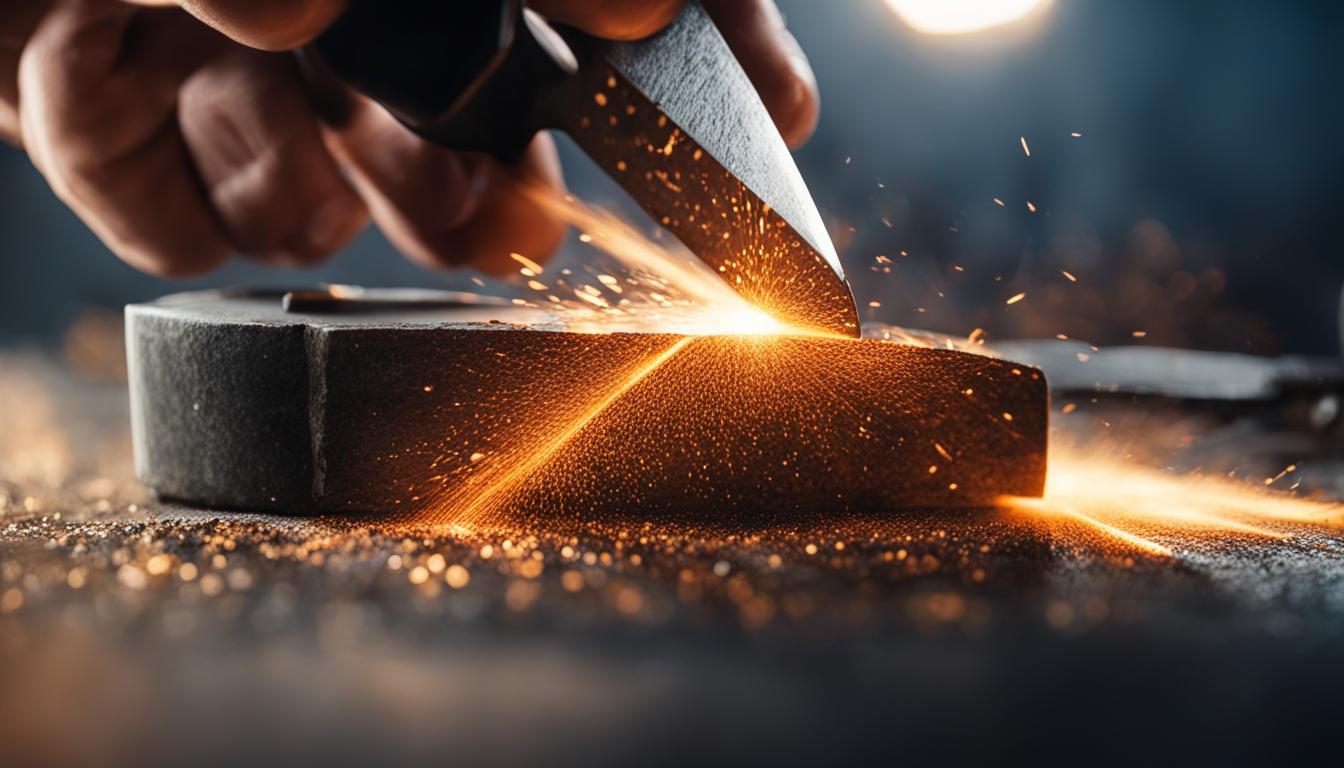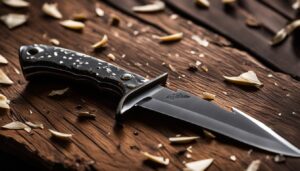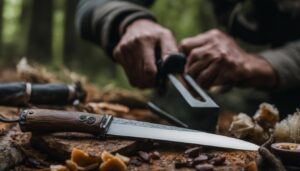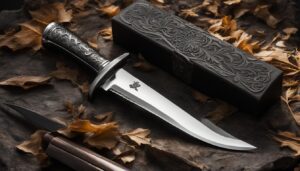Proper care and maintenance are essential for maximizing the lifespan of your hunting knife’s edge. By avoiding common mistakes and implementing effective sharpening techniques, you can ensure that your blade remains sharp and durable throughout its use.
When it comes to hunting, having a reliable and sharp knife is crucial. The edge of your hunting knife can endure a lot of wear and tear, especially during outdoor activities. To make sure your knife stays in top shape, it’s important to understand how to maintain its edge and increase its durability.
Key Takeaways:
- Proper care and maintenance are essential for maximizing your hunting knife’s edge lifespan.
- Avoid common mistakes while sharpening your knife, such as starting with an extremely dull blade or using the wrong sharpening technique.
- Understanding the science behind knife sharpening can help you achieve a sharper and more efficient edge.
- There are different types of knife sharpeners available, including electric and manual options. Choose the one that suits your needs.
- Honing your knife with a leather strop and regularly maintaining its edge can help preserve its sharpness.
Common Mistakes to Avoid while Sharpening a Knife
When it comes to sharpening your hunting knife, avoiding common mistakes is crucial to achieve the best results. Many people fail in their knife sharpening endeavors due to various reasons. Here are some of the most common mistakes to avoid:
- Starting with an extremely dull knife: Trying to sharpen a blade that is extremely dull can be a frustrating and time-consuming process. It’s important to ensure that your knife is not excessively dull before starting the sharpening process.
- Not seeing progress and changing techniques: Sharpening a knife takes time and patience. It’s important to stick to a consistent technique and give it time to work. Switching techniques too soon or not allowing enough time for the sharpening process can lead to subpar results.
- Progressing to a finer medium too soon: When sharpening a knife, it’s important to start with a coarse grit and gradually progress to finer grits. Jumping to a finer medium too soon can result in an incomplete sharpening and a less effective edge.
- Using too steep of a sharpening angle: The angle at which you sharpen your knife plays a significant role in the final result. Using too steep of an angle can weaken the blade and make it more prone to damage. It’s important to find the optimal angle for your knife and maintain it throughout the sharpening process.
By avoiding these common mistakes and adopting proper sharpening techniques, you can ensure that your hunting knife is sharpened effectively and maintains its edge for a longer lifespan.
Mastering the art of knife sharpening requires practice and knowledge. Understanding the common mistakes to avoid can save you time and frustration, allowing you to sharpen your hunting knife with confidence. Remember, starting with a reasonably sharp blade, sticking to a consistent technique, progressing to finer grits gradually, and using the correct sharpening angle are all key elements to successful sharpening. By honing your sharpening skills and avoiding these mistakes, you can keep your hunting knife in optimal condition and ready for any outdoor adventure.
The Science Behind Knife Sharpening
When it comes to sharpening a hunting knife, understanding the science behind it is essential for achieving optimal results. The physics of sharpness play a crucial role in determining the cutting performance and efficiency of a blade. A sharp knife reduces the force required for cutting tasks and enhances safety by reducing the risk of accidents.
At a microscopic level, the structure of a dull knife’s blade consists of jagged teeth that make it less effective. On the other hand, a well-sharpened knife’s blade is smooth and has a finely honed edge. Recent scientific studies have confirmed the benefits of sharper blades, showing that they require less force to perform cutting tasks compared to dull blades.
Understanding the science of knife sharpening allows us to implement sharpening techniques that preserve the blade’s sharpness and enhance its durability. By maintaining the proper angle and using the right sharpening tools, we can ensure that the blade retains its sharp edge for longer periods, making it more effective for hunting and other outdoor activities.
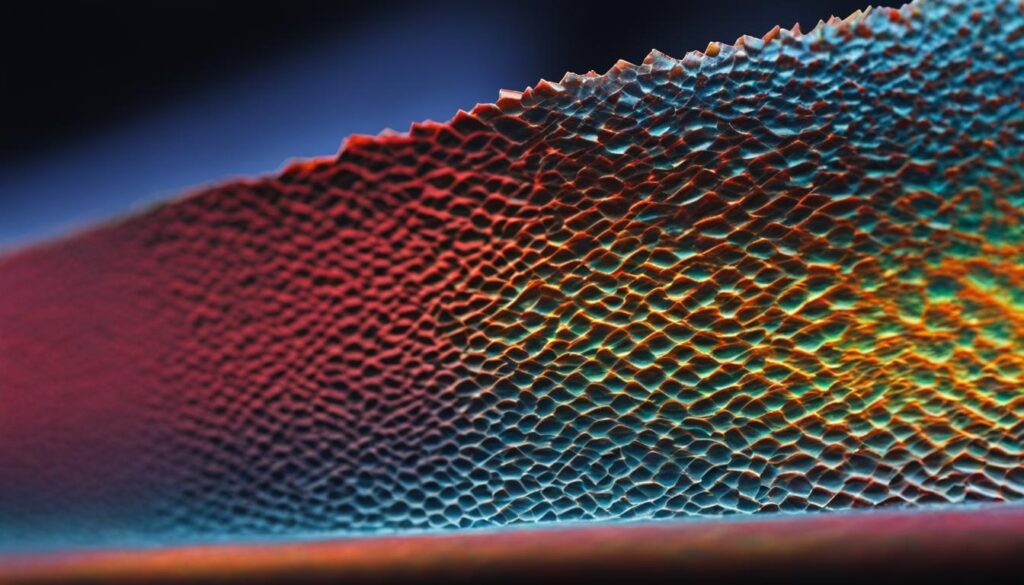
The Microscopic Structure of a Knife Blade
According to Dr. Smith, a renowned materials scientist, a sharp knife’s blade has a finely honed edge consisting of aligned, well-defined microscopic grooves. In contrast, a dull blade has irregular, jagged edges that result in a less efficient cutting performance.
In summary, the science behind knife sharpening reveals the importance of maintaining a sharp edge for optimal cutting performance and safety. Understanding the microscopic structure of a knife blade and how it affects its cutting abilities allows us to implement effective sharpening techniques. By following the principles of knife sharpening science, we can ensure that our hunting knives remain sharp, durable, and efficient.
Types of Knife Sharpeners
When it comes to sharpening your hunting knife, there are two main options to choose from: electric sharpeners and manual sharpeners. Each type has its own advantages and considerations that you should keep in mind when making your decision. Let’s take a closer look at each option to understand their differences and features.
Electric Sharpeners
Electric sharpeners offer convenience and speed, making them an attractive option for many hunters. These sharpeners typically feature rotating abrasive wheels or belts that quickly remove metal from the blade to create a sharp edge. They are easy to use, requiring little manual effort, and can produce consistent results. Some electric sharpeners even come with multiple stages, allowing you to achieve different levels of sharpness.
However, it’s important to note that electric sharpeners may not be suitable for all types of knives. They are generally better suited for blades with straight edges and may not be ideal for serrated or curved blades. Additionally, if you’re working with an expensive or heirloom-quality knife, you may want to exercise caution when using an electric sharpener, as it can quickly remove a significant amount of metal from the blade.
Manual Sharpeners
Manual sharpeners, such as whetstones or honing rods, provide a more hands-on approach to knife sharpening. These sharpeners require some skill and practice to use effectively, but they offer greater control and versatility. With a manual sharpener, you have the ability to adjust the angle and pressure to suit your specific needs. This makes them a popular choice among experienced hunters and outdoor enthusiasts.
One of the main advantages of manual sharpeners is that they allow you to maintain a finer edge on your blade. They remove less metal compared to electric sharpeners, which can be beneficial for preserving the lifespan of your knife. However, it’s important to keep in mind that manual sharpening does require more time and effort compared to electric sharpening, especially when sharpening larger or more damaged blades.
| Electric Sharpeners | Manual Sharpeners |
|---|---|
| Convenient and fast | Greater control and versatility |
| May not be suitable for all types of knives | Requires skill and practice |
| Can remove a significant amount of metal | Maintains a finer edge |
In summary, choosing the right type of knife sharpener depends on your specific needs and preferences. If convenience and speed are your top priorities, an electric sharpener may be the right choice for you. On the other hand, if you value control and want to maintain a finer edge on your blade, a manual sharpener may be more suitable. Ultimately, it’s important to consider the type of knife you have, your sharpening experience, and the level of sharpness you want to achieve when making your decision.
How to Hone a Knife with Leather
Honing a knife with leather is a simple yet effective method to maintain its sharpness and prolong its lifespan. The process involves using a leather strop coated with a honing compound, which helps refine and align the blade’s edge. Honing is different from sharpening, as it doesn’t remove metal but rather realigns the microscopic teeth on the edge, keeping the blade in peak condition.
To hone a knife with leather, start by applying a thin layer of honing compound to the surface of the strop. Hold the knife at a consistent angle and with equal pressure, then draw the entire blade along the strop, ensuring both sides make contact. Repeat this motion several times, alternating between sides, to achieve an even honing effect.
When selecting a honing compound, consider the grit level and coarseness that best suits your knife. Honing compounds come in various formulations, ranging from coarse to fine. Coarser compounds are effective for maintaining heavy-duty blades, while finer compounds are suitable for finer or more delicate knives. Be sure to clean the knife after honing and wipe off any excess honing compound to prevent contamination during future use.
Incorporating the practice of honing with leather into your knife maintenance routine can significantly extend the time between sharpenings, keeping your hunting knife consistently sharp and ready for use. Regular honing ensures that your blade remains in optimal condition, improving cutting performance and enhancing your overall hunting experience. Remember, a well-maintained edge is essential for achieving clean and precise cuts in the field.
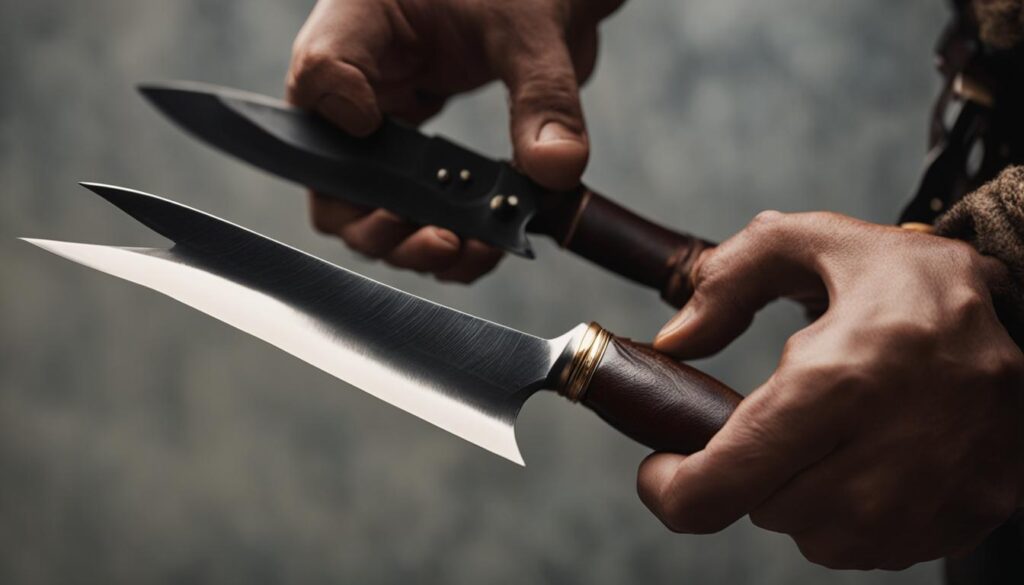

The Benefits of Honing with Leather:
- Preserves the existing sharpness of the blade
- Helps realign the microscopic teeth on the edge
- Keeps the blade consistently sharp and ready for use
- Reduces the frequency of full sharpening
- Improves cutting performance and precision
Recommended Honing Compounds:
| Compound Type | Grit Level | Recommended Use |
|---|---|---|
| Coarse | 120-220 | For heavy-duty blades and quick realignment |
| Medium | 400-800 | For general-purpose knives and regular maintenance |
| Fine | 1000-2000 | For fine or delicate blades and final touch-ups |
“Honing with leather is an effective technique to maintain the sharpness of your hunting knife. It’s a simple process that can be easily incorporated into your regular maintenance routine.” – Knife Sharpening Expert
How Often Should You Hone Your Knife?
Proper maintenance of your hunting knife includes regular honing to maintain its sharpness and cutting performance. The frequency at which you should hone your knife depends on several factors, such as the frequency of use and the type of tasks performed. As a general guideline, it is recommended to hone your knife every 2-3 months or whenever you notice a decrease in cutting efficiency.
Honing your knife regularly helps to preserve the sharpness of the blade and maintain its edge. By removing any micro-burrs or imperfections that occur during use, honing keeps the blade in optimal condition. This ensures that your hunting knife remains sharp and efficient, ready for any outdoor adventure.
However, it’s important to note that honing is not a substitute for sharpening. While honing aligns the edge of the blade, sharpening actually removes material to create a new edge. If your knife becomes dull or loses its sharpness despite regular honing, it’s time to sharpen it. Sharpening should be done less frequently than honing, as it removes more material and can eventually shorten the lifespan of the blade.
Factors Influencing Honing Frequency
The frequency at which you should hone your knife may vary depending on the following factors:
- Frequency of use: If you use your hunting knife frequently, such as for daily or regular hunting trips, it may require more frequent honing to maintain its edge.
- Type of tasks: Different tasks can affect the blade differently. More demanding tasks, such as field dressing or skinning game, can cause the blade to dull faster and may require more frequent honing.
- Blade material: The type of steel used in the blade’s construction can also influence how often it needs to be honed. Some steels retain their edge better than others, meaning they may require less frequent honing.
By understanding these factors and regularly honing your hunting knife, you can ensure that it remains sharp and ready for action whenever you need it.
| Factors | Honing Frequency |
|---|---|
| Frequency of use | Every 2-3 months or as needed |
| Type of tasks | May require more frequent honing for demanding tasks |
| Blade material | Varies depending on the type of steel used |
Conclusion
To maximize the lifespan of your hunting knife’s edge, it is crucial to prioritize proper care, maintenance, and sharpening techniques. By avoiding common mistakes, understanding the science behind sharpness, and selecting the right sharpening method, you can ensure the durability and longevity of your blade.
First and foremost, it is important to avoid common mistakes when sharpening your hunting knife. Starting with an extremely dull knife, not observing progress and changing techniques, progressing to a finer medium too soon, and using too steep of a sharpening angle are all pitfalls to avoid for optimal sharpening results.
Furthermore, understanding the science behind knife sharpening is key to achieving a sharp and efficient edge. Scientific studies have shown that sharper blades require less force for cutting tasks, reducing the risk of accidents and enhancing cutting performance. By honing your knife with a leather strop, you can effectively maintain its sharpness and preserve the results of previous sharpening.
Regular honing is essential for maintaining the edge of your hunting knife. Aim to hone your knife every 2-3 months or whenever you notice a decrease in cutting performance. This maintenance routine will help preserve the sharpness and durability of the blade, ensuring optimal performance during hunting or other outdoor activities.
In conclusion, maximizing the lifespan of your hunting knife’s edge requires a combination of proper care, maintenance, and sharpening techniques. By avoiding common mistakes, understanding the science behind sharpness, and regularly honing your knife, you can maximize its durability and ensure it remains sharp and efficient for years to come.
FAQ
What common mistakes should I avoid while sharpening a knife?
Common mistakes to avoid include starting with an extremely dull knife, not seeing progress and changing techniques, progressing to a finer medium too soon, and using too steep of a sharpening angle.
Why is understanding the science behind knife sharpening important?
Understanding the science behind knife sharpening is crucial in order to achieve a sharp and efficient edge. A sharper blade reduces the risk of accidents and enhances cutting performance. Recent scientific studies support the idea that sharper blades require less force for cutting tasks.
What are the different types of knife sharpeners?
There are two main types of knife sharpeners: electric and manual. Electric sharpeners offer convenience and speed, while manual methods such as whetstones or honing rods provide control and versatility. Factors to consider when choosing a sharpener include grit size, material type, and desired sharpening results.
How do I hone a knife with leather?
Honing a knife with leather is a simple yet effective way to maintain its sharpness. The process involves using a leather strop coated with a honing compound. Proper technique involves maintaining equal pressure, ensuring the entire blade passes along the strop, and using both sides of the leather strop. Various types of honing compounds are available, offering different levels of grit and coarseness.
How often should I hone my knife?
The frequency of honing your hunting knife depends on factors such as the frequency of use and the type of tasks performed. As a general guideline, it is recommended to hone your knife every 2-3 months or whenever you notice a decrease in cutting performance. Regular honing helps maintain the sharpness and durability of the blade.
Source Links
- https://www.itstactical.com/warcom/knives/how-to-sharpen-a-knife-while-minimizing-mistakes-and-maximizing-cutting-edge-performance/
- https://heinnie.com/blog/knife-sharpening-essentials-a-guide-for-outdoor-enthusiasts/
- https://chefsvisionknives.com/blogs/chefs-vision-blog/how-to-hone-a-knife-with-leather-a-quick-guide
